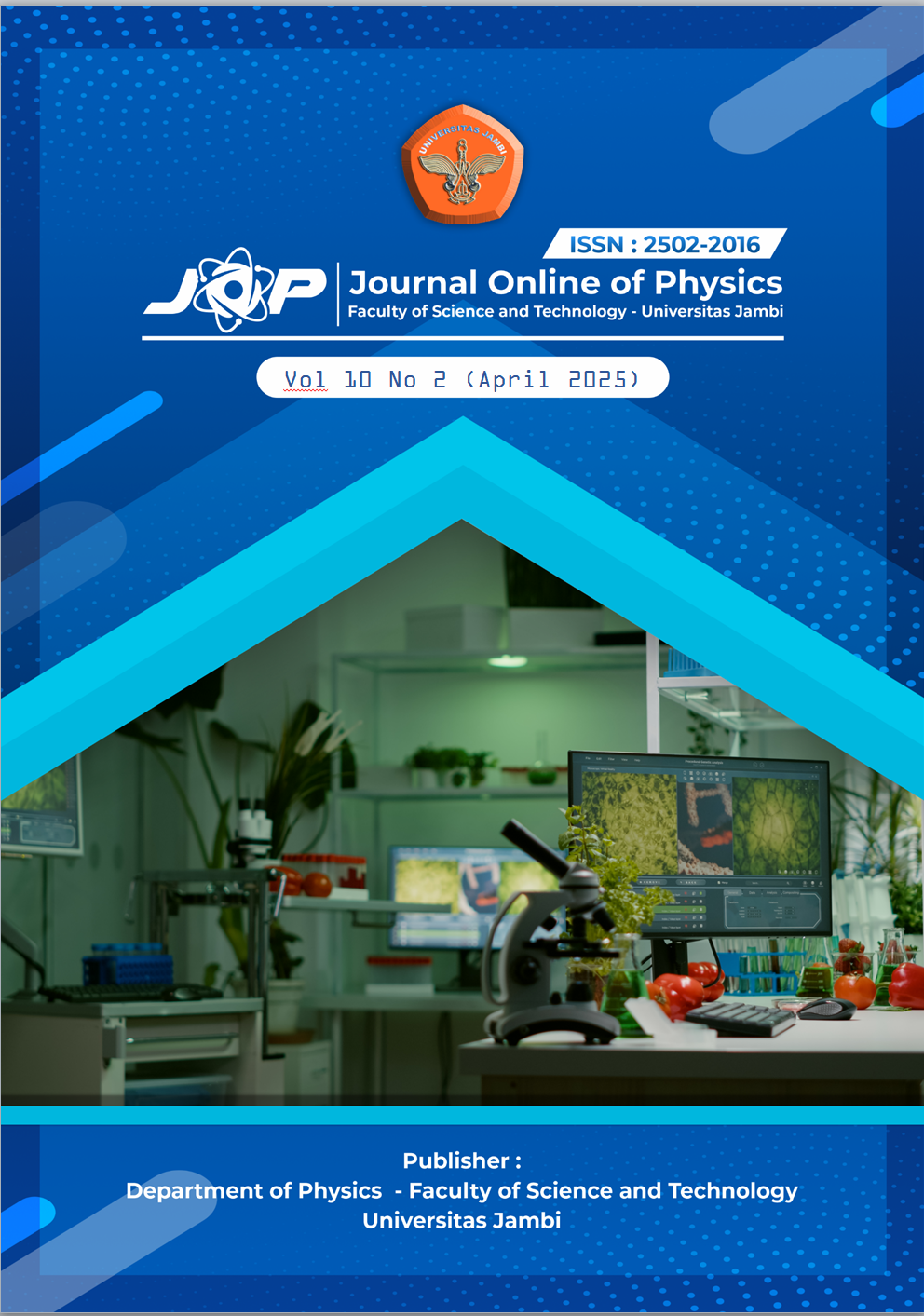TINJAUAN TEMPERATUR PERMUKAAN DAN ANGIN DI WILAYAH TROPIS DUNIA
DOI:
https://doi.org/10.22437/jop.v10i2.42452Keywords:
Temperatur Permukaan Udara, anomali SAT, angin timuran, variabilitas iklim, pemanasan globalAbstract
Wilayah tropis dunia merupakan daerah dengan temperatur yang relatif tinggi sepanjang tahun. Temperatur wilayah ini tentunya mempengaruhi berbagai aspek kehidupan, khususnya di wilayah tersebut. Penelitian ini menganalisis rata-rata bulanan temperatur permukaan udara (SAT) dan anomali SAT dari tahun 1940 hingga 2023, serta pola anomali angin di wilayah tropis. Hasil penelitian menunjukkan bahwa rata-rata SAT berkisar antara 23.5°C hingga 26.5°C, dengan puncak temperatur terjadi pada Mei dan Oktober setiap tahunnya. Tren jangka panjang menunjukkan peningkatan SAT dari tahun ke tahun, yang konsisten dengan pemanasan global. SAT terendah terjadi pada tahun 1943, sementara SAT tertinggi tercatat pada tahun 2024. Rata-rata anomali SAT menunjukkan variasi bulanan, dengan nilai positif pada Februari, April, Juni, dan Desember, yang kemungkinan dipengaruhi oleh fenomena atmosfer seperti El Niño dan La Niña. Analisis anomali angin mengungkap dominasi angin timuran di wilayah tropis, yang lebih cepat di atas lautan dibandingkan daratan akibat perbedaan gesekan permukaan. Variasi musiman menunjukkan perubahan pola angin, dengan puncak angin timuran pada Juni-Agustus (JJA) dan transisi ke angin baratan pada September-November (SON). Fenomena ini terkait dengan sistem sirkulasi atmosfer global, seperti Sel Hadley, angin pasat, Monsun Asia, dan Dipole Mode Indian Ocean (IOD). Penelitian ini menegaskan bahwa pola SAT dan angin tropis mengalami perubahan yang sejalan dengan variabilitas iklim global, sehingga diperlukan studi lebih lanjut untuk memahami dampak fenomena iklim terhadap dinamika atmosfer
Downloads
References
Ahn, S., Seo, W. S., Kwon, H., Lee, M. H., Kim, S. J., Lee, B. Y., Park, S. J., & Choi, T. (2024). Influence of Foehn-Like Winds on Near-Surface Temperature at Jang Bogo Station, Terra Nova Bay, East Antarctica. Geophysical Research Letters, 51(22). https://doi.org/10.1029/2024GL110348
Hersbach, H., Bell, B., Berrisford, P., Hirahara, S., Horányi, A., Muñoz-Sabater, J., Nicolas, J., Peubey, C., Radu, R., Schepers, D., Simmons, A., Soci, C., Abdalla, S., Abellan, X., Balsamo, G., Bechtold, P., Biavati, G., Bidlot, J., Bonavita, M., … Thépaut, J. N. (2020). The ERA5 global reanalysis. Quarterly Journal of the Royal Meteorological Society, 146(730), 1999–2049. https://doi.org/10.1002/qj.3803
Holton, J. R., & Hakim, G. J. (2012). An introduction to dynamic meteorology: Fifth edition. In An Introduction to Dynamic Meteorology: Fifth Edition (Vol. 9780123848). https://doi.org/10.1016/C2009-0-63394-8
Huang, J., Jones, B., Thatcher, M., & Landsberg, J. (2020). Temperature impacts on utility-scale solar photovoltaic and wind power generation output over {Australia} under {RCP} 8.5. Journal of Renewable and Sustainable Energy, 12(4), 46501. https://doi.org/10.1063/5.0012711
Huang, X., Huang, X., Han, S., Han, S., Shi, C., & Shi, C. (2022). Evaluation of Three Air Temperature Reanalysis Datasets in the Alpine Region of the Qinghai–Tibet Plateau. Remote Sensing. https://doi.org/10.3390/rs14184447
IPCC. (2021). Climate Change 2021: The Physical Science Basis. Contribution of Working Group I to the Sixth Assessment Report of the Intergovernmental Panel on Climate Change. In Cambridge University Press.
IPCC. (2023). Summary for Policymakers: Synthesis Report. Climate Change 2023: Synthesis Report. Contribution of Working Groups I, II and III to the Sixth Assessment Report of the Intergovernmental Panel on Climate Change, 1–34.
Jones, P. D., New, M., Parker, D. E., Martin, S., & Rigor, I. G. (1999). Surface air temperature and its changes over the past 150 years. Reviews of Geophysics, 37(2), 173–199. https://doi.org/10.1029/1999RG900002
Mufti, F., & As’ari. (2014). Pengaruh Angin Dan Kelembapan Atmosfer Lapisan Atas. Jurnal Mipa Unsrat Online, 3(1), 58–63.
Nur Ilahi, I. F., Dewi, B. P., Muhammad, Y. I. N., Wibowo, B. P., & Giarno, G. (2023). Kajian Perbandingan Arah Angin Permukaan Terhadap Unsur Cuaca Dan Iklim Pada Wilayah Pesisir Dan Dataran Tinggi (Studi Kasus : Stasiun Meteorologi Soekarno-Hatta Dan Stasiun Meteorologi Citeko). Jurnal Sains Dan Pendidikan Fisika, 19(1), 109. https://doi.org/10.35580/jspf.v19i1.42933
Roy, S. B., & Traiteur, J. J. (2010). Impacts of wind farms on surface air temperatures. Proceedings of the National Academy of Sciences of the United States of America, 107(42), 17899–17904. https://doi.org/10.1073/pnas.1000493107
Saji, N. H., Goswami, B. N., Vinayachandran, P. N., & Yamagata, T. (1999). A dipole mode in the tropical Indian ocean. Nature, 401(6751), 360–363. https://doi.org/10.1038/43854
Saji, N. H., & Yamagata, T. (2003). Structure of SST and surface wind variability during Indian Ocean Dipole mode events: COADS observations. Journal of Climate, 16(16), 2735–2751. https://doi.org/10.1175/1520-0442(2003)016<2735:SOSASW>2.0.CO;2
Schott, F. A., Xie, S. P., & McCreary, J. P. (2009). Indian ocean circulation and climate variability. Reviews of Geophysics, 47(1), 1–46.
https://doi.org/10.1029/2007RG000245
Suhadi, Jamiatul, K. P., Iskhaq, I., Supari, Muhammad, I., Melly, A., & Hamdi, A. (2024). Morlet’s Wavelet analysis on El Niño Southern Oscillation (ENSO) and the Indian Ocean Dipole (IOD) for 84 years: 1940- 2023. Indonesian Physical Review, 7(2), 250–258.
Trenberth, K. E., Fasullo, J. T., & Kiehl, J. (2009). Earth’s global energy budget. Bulletin of the American Meteorological Society, 90(3), 311–323. https://doi.org/10.1175/2008BAMS2634.1
Trenberth, K. E., & Shea, D. J. (2005). Relationships between precipitation and surface temperature. Geophysical Research Letters, 32(14), 1–4. https://doi.org/10.1029/2005GL022760
Wallace, J. M., & Hobbs, P. V. (2006). Atmospheric Science: An Introductory Survey: Second Edition. In Atmospheric Science: An Introductory Survey: Second Edition. https://doi.org/10.1016/C2009-0-00034-8
Webster, P. J., Magaña, V. O., Palmer, T. N., Shukla, J., Tomas, R. A., Yanai, M., & Yasunari, T. (1998). Monsoons: processes, predictability, and the prospects for prediction. Journal of Geophysical Research: Oceans, 103(C7), 14451–14510. https://doi.org/10.1029/97jc02719
Webster, P. J., Moore, A. ., Loschnigg, J. P., & Leben, R. R. (1999). Coupled ocean-atmosphere dynamics in the Indian Ocean during 1997-98. Nature, 401(6751), 356–360. https://doi.org/10.1038/43848
WMO. (2021). State of the Global Climate 2020 (Issue 1264). https://library.wmo.int/index.php?lvl=notice_display&id=21880#.YHg0ABMzZR0
Downloads
Published
How to Cite
Issue
Section
License
Copyright (c) 2025 Suhadi Suhadi, Jamiatul Khairunnisa Putri

This work is licensed under a Creative Commons Attribution 4.0 International License.











